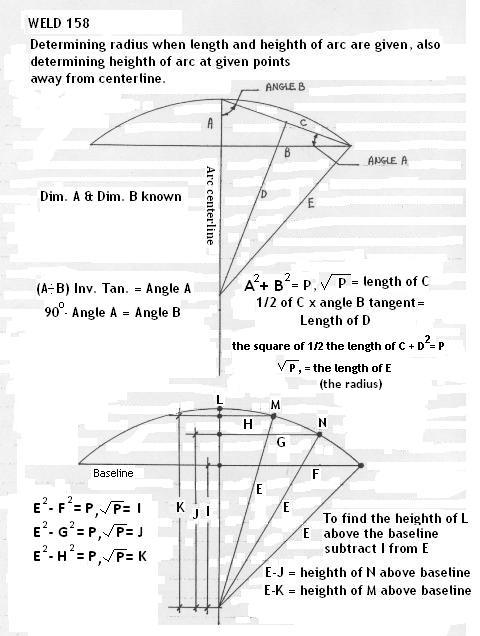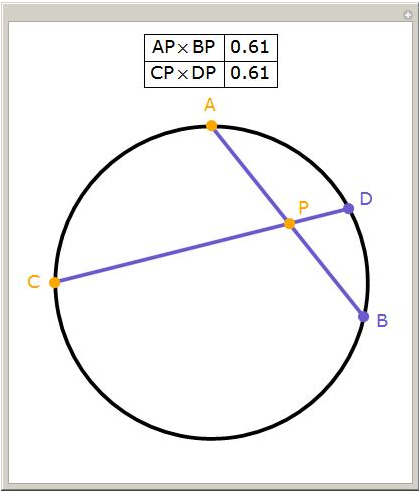Hello everyone, here is a bit more to add to portions of this thread. I have included a number of attachments to describe and hopefully show how right angle trig. and other basic mathematical functions can help with certain layout and fabrication challenges. One example for this method might be to aid with plotting radius's on large cone sections where the radius is just too large to use a trammel method or similar direct measurement method. Another might have to do with providing a consistent arc for a truss or other sort of arched structure. Best regards, Allan
Inspirational story Allan! All students bring their life-long accumulation of experiences to the classroom. Some are amazing. Others are, well, interesting...
The first time I encountered a problem like this, I found the solution in Frankland's "Pipe Fitter's and Pipe Welder's Handbook." He says that L = 2 x SQRT(A x B), where L is the chord length, while A + B = the circle's diameter. To make the equation match the variables in your sketch, we have 2A = 2 x SQRT(B x C), where A & B are known. The goal is to find C because the diameter = B + C.
Your student's formula: Diameter = (A^2 + B^2)/B
Frankland's version: 2A = 2 x SQRT(B x C). Manipulating Frankland's statement, we have: A = SQRT(B x C) → A^2 = B x C → C = A^2/B → B + C = B + A^2/B → B + C = B^2/B + A^2/B → B + C = (A^2 + B^2)/B
Since diameter = B + C, the last statement says the same thing as your student: Diameter = (A^2 + B^2)/B.
Frankland's general statement about chords and diameters is just one of his little gems. It's on page #9 of the 1969 edition. (I've got newer--and older--editions. I just don't have them with me right now).
But there's an even more basic result from geometry that speaks to this problem. It involves ANY two chords that intersect within a circle--not limited to right angles or diameters. From this more fundamental Theorem, you can derive Frankland's formula AND (as I have tried to show here) your student's formula. Maybe someone else would like to share it. If not, I'll be back!
Hey all. I'm back with an explanation of what I called "a more fundamental theorem" that can explain both Frankland's equation and Allan's student's equation. It's called the Intersecting Chord Theorem. I tried to find out more about its origin, but came up empty handed--I don't know who deserves the credit for this beautiful little theorem. It simply states that, if chords intersect at a point P within a circle, as in the attached illustration, the products of the "pieces" of the chords will be equal. In the picture, the product of lengths AP x BP = CP x DP. It works for all intersecting chords, not just those at right angles.
In Allan's original "find the diameter" problem, the known chord's perpendicular bisector is the diameter being sought.
Hello dnelson2031, I am apparently a bit foggy in the brain, as I am not "seeing" how this particular item is applied to specific problem solving or application. So please, educate me and show me how this applies. Best regards, Allan
Sure. Part of your original problem was to find the diameter (radius) of a circle that passes through three points. Specifically, the three points would be the endpoints of a chord and the maximum height of the arc that passes through them. The diagram below shows a random chord as segment AB (9.06 cm) and the maximum height (segment CD) as 2.70 cm. According to the Intersecting Chords Theorem, the length of segment DE (the "rest" of the diameter), is related to the known distances as follows:
AD x DB = CD x DE
Substituting the three known values, we have:4.53 x 4.53 = 2.70 x DE
Solve this equation for DE = 4.53 x 4.53 / 2.70 = 7.60 (rounded to two digits). Now we know that the diameter is (approximately) 10.30 cm.
Your student's equation yields the same result:
(4.53^2 + 2.70^2) / 2.70 = 10.30 (rounded to two decimal places)
There's nothing wrong with your student's formula--in fact, I'm crazy impressed that he (?) brought it into your classroom! And there's nothing wrong with Frankland's formula relating chord length, maximum height of arc, and diameter. All I'm saying is that, by relying on an even more fundamental result, there's less stuff to remember! Plus, it applies to ALL chords. (Surprizingly, even those that do not intersect within the circle.)
Dan

Hello Dan, and thanks for the explanation. I will play around with it when I get some time. Had another student bring another example in to me. I'll see if it matches any of the others that folks have shared in this thread. If not I'll see about including it here. I am old, but I'm still teachable, so this thread has been really good for me. Thanks and best regards, Allan



